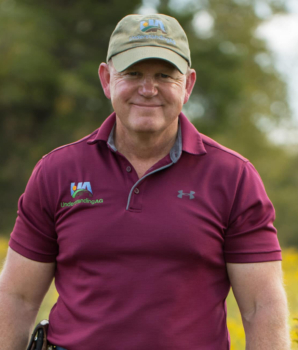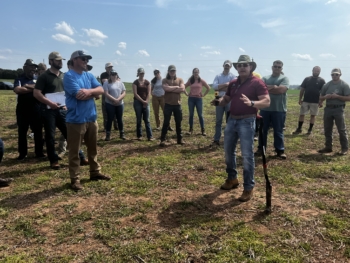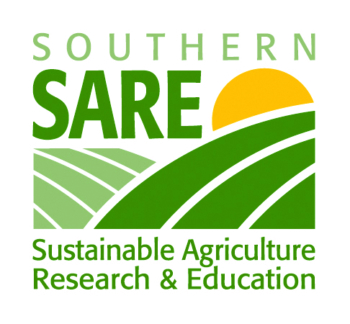Regenerative Grazing in the South: Case Studies from Mississippi
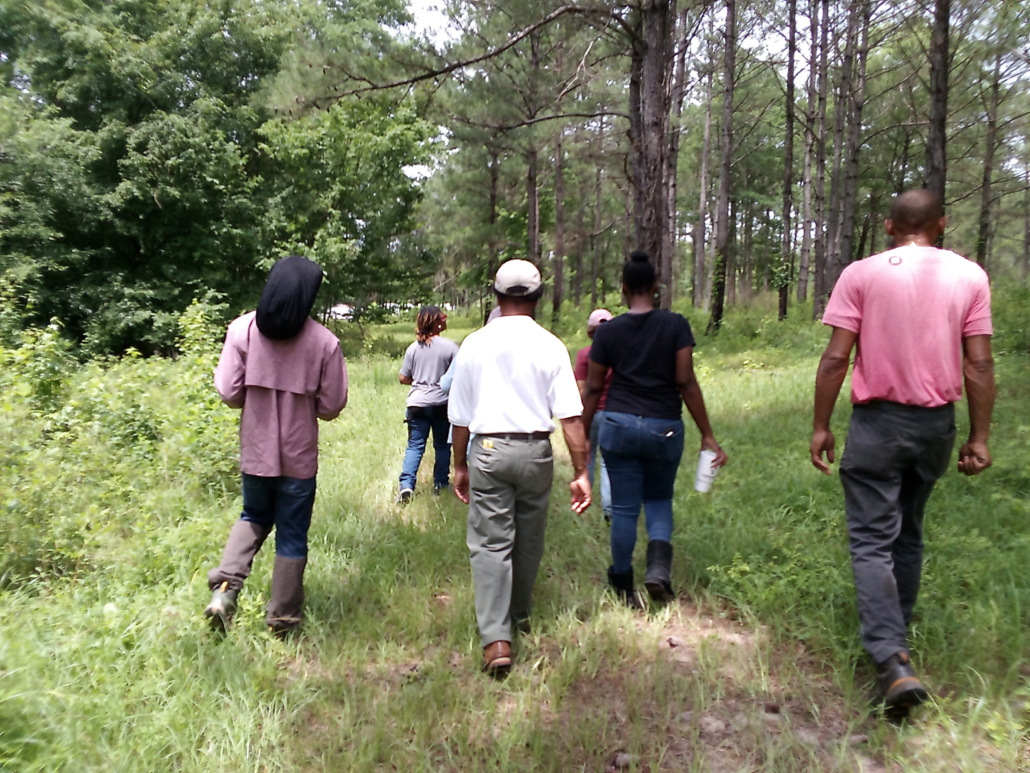
Women, Livestock, and the Land program participants gathered in May 2024. Photo: Felicia Bell, NCAT
By Felicia Bell and Lee Rinehart, NCAT Sustainable Agriculture Specialists
Abstract
This publication tells the stories of four pioneering Mississippi farmers who are trying out new practices to enhance soil function and enable the soil to catch and hold more water. These regenerative practices are particularly important to resource-limited farmers, as they can pave the way for building more resilient farms and can dramatically impact the community through increased food security. These stories highlight not only successes but also the barriers many farmers in the South experience in adopting regenerative practices. Together, these stories provide a snapshot of the real-world experience of Mississippi producers, illuminating the importance of networks for providing peer support and illustrating how regenerative grazing is slowly gaining ground with small farmers in Mississippi.
Contents
Introduction
The Mississippi Working Group
Partnership with Holistic Management International
Identifying Barriers
Case Study: Mr. James Burch, Colemans Farm
Case Study: Kelli Randle, Home Grown Farms
Case Study: Elmarie Brooks
Conclusion
References
Resources
Introduction
Regenerative grazing that builds soil health and improves water infiltration and storage holds great promise for livestock producers coping with unpredictable climatic conditions, but it has been slow to catch on in the southern United States. In 2021, the Southern Sustainable Agriculture Research and Education (Southern SARE) program awarded a three-year grant to the National Center for Appropriate Technology (NCAT) for a project called Soil for Water, whose purpose was to accelerate the adoption of regenerative grazing in four southern states: Arkansas, Mississippi, Texas, and Virginia.
During either drought or flooding events, well-aggregated soil can capture more water than soil in poor condition. The Soil for Water project has been attempting to raise awareness of this and encourage experimentation on farms and ranches throughout the South that are coping with increasingly uncertain climatic conditions. The project emphasized and promoted five soil health principles: 1) keep soil covered; 2) manage soil disturbance; 3) increase biodiversity; 4) maintain living roots in the ground; and 5) integrate livestock.
This publication is the story of our work in Mississippi and how Mississippi graziers have come together to develop grazing groups for education, mutual support, and inspiration. It provides a brief look at four families who are prioritizing stewardship of their land while also seeking profit and a great quality of life.
The Mississippi Working Group
The Mississippi Soil for Water working group was developed to engage producers in an investigation of how the principles of regenerative agriculture could positively impact the lives of small farmers in the state, especially those who have limited resources. We greatly appreciated the support of Dr. Rocky Lemus, an Extension Forage Specialist and Research Professor with Mississippi State University Extension. Dr. Lemus served as a technical advisor, conducting farm visits to assist farmers with soil, water, and forage management and especially to learn more about each farmer and their needs.
I (Felicia Bell) had the pleasure of leading the working group. Because of my deep connection to Mississippi, the land, and the people in my community, I believe everyone deserves the right to access healthy foods. I also believe this can become a reality through the collective efforts of small sustainable farmers.
More about Felicia
Felicia Bell is a fourth-generation farmer, mother, grandparent, NCAT Sustainable Agriculture Specialist, and founding member of RD&S Farm, LLC, in Brandon, Mississippi. She has been a volunteer in Ghana working with small farmers on business management and marketing and is fascinated with traditional agriculture, especially African farming methods. Her passion for subsistence farming and homesteading has led her to focus her work in Mississippi on assisting small-scale farmers with resources to lower their costs and increase the viability of their farm enterprises. In 2019, Felicia discovered and was powerfully affected by the work of Allan Savory. She has implemented the principles of holistic management successfully on her own farm and is committed to bringing these principles to small farmers in the South.
Partnership with Holistic Management International
Because the overall goal of our project was to improve profits, land health, productivity, and quality of life, I decided to work closely with Holistic Management International (HMI) and introduce the principles of holistic management to small farmers in Mississippi. Based on my own experience, I believe these principles can help farmers of any background, no matter where they are in the world and whether they have a 30-acre farm, a 10-acre farm, or a 3-acre farm. Savory’s principles are still relatively unknown among small, limited-resource farmers in Mississippi. I hoped that hearing about Savory’s principles for the first time from someone who looks like them and has succeeded could powerfully impact Mississippi farmers.
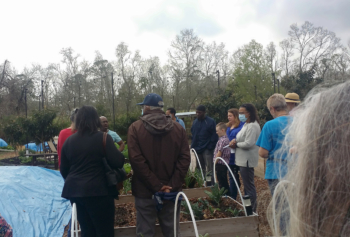
Tracy Galloway of Galloway Family Farm in Ocean
Springs, Mississippi. Photo: Felicia Bell, NCAT
Specifically, the project offered farmers the opportunity to participate in HMI’s Regenerative Agriculture Mentorship Program (RAMP). RAMP is a relatively new program designed to engage farmers through a peer group. Facilitated meetings foster teamwork and enhance each farmer’s progress towards reaching their whole-farm goals. Project leaders wanted to evaluate the effectiveness of the RAMP approach in Mississippi, where it had never been tried before.
Linda Pechin-Long, an HMI Educator, led the RAMP effort in Mississippi. The effort included intensive classroom instruction, field days, discussions, and mutual sharing of goals and strategies. This project also introduced the concept of Safe to Fail grazing trials to participants. In these trials, the producer sections off a small parcel of their pasture to observe how plants and ecosystems respond to high-density grazing. These trials were a crucial part of our work and are discussed below in detail.
Identifying Barriers
From the beginning of the project, we were aware of a critical barrier to the adoption of regenerative practices. Black farmers in Mississippi, as in all other southern states, have experienced a long history of racial discrimination in accessing financial and technical assistance for programs designed to support environmental conservation, land acquisition, and infrastructure improvements on small farms. This history of discrimination has tended to result in low participation in education and outreach programs. While Black farmers in the South tend to distrust programs that promise financial and economic benefits from conservation practices, they also have a long history of using regenerative and African indigenous cooperative farming practices. We wanted to understand these attitudes better and try new ways of working with these audiences.
We are sharing what we learned through the stories of four Mississippi farmers from our working group, highlighting the barriers they faced in adopting regenerative practices and the paths they’ve taken to overcome those barriers. These are the stories of four farmers in the working group who learned and adopted new practices together.
Case Study: Mr. James Burch, Colemans Farm
Lexington, Mississippi
The Struggle to Move Forward
Mr. Burch is a diversified farmer producing high tunnel vegetables and beef cattle. “I am a retired veteran,” says Mr. Burch. “I’ve participated in many programs offered by NCAT and any other entity that I can get information from to better my operation.” His knowledge has grown over the years and has, as he relates, “definitely improved” his operation. “I have learned a lot from NCAT on how to set up my operation to graze regeneratively from attending the Soil Health Academy with Dr. Allen Williams and colleagues. What an experience!”
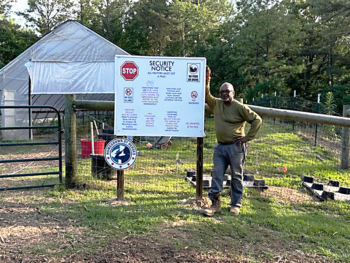
James Burch. Photo: Felicia Bell, NCAT
Mr. Burch brought his knowledge and passion to bear in our project by hosting a field day on his farm for 25 participants. He has also agreed to lead the Farmer Veteran Coalition’s Mississippi chapter. He is an advocate for USDA programs, but he always says, “you have to learn the programs by asking a lot of questions.” This is a theme that runs throughout the experiences of the farmers we have engaged with in Mississippi.
When Mr. Burch retired from the military, he moved back to the farm he had lived on as a child, at a time when most people of African descent were leaving the farm. Though he didn’t intend to come back to Mississippi, once he did, he got bit by the bug of providing for the community. He saw the need of the community and wanted to put his leadership skills to use with the people who knew him, remembered him from his childhood, and needed information on acquiring resources to move forward in their own farming enterprises.
Armed with information he had gained from Extension, USDA programs, and NCAT, Mr. Burch saw an opportunity to pull people together to create a cooperative of farmers in his area. With a voracious appetite for education, he attended every meeting in his area to build his toolbox, not only for his own farm, but for the farmers in his informal circle. He started implementing new practices on his farm by taking every nugget of information he could acquire, and it’s phenomenal what he has accomplished. His advice? Go to the local USDA Service Center, ask questions, and drill it down until you get what you need.
Mr. Burch is transparent in sharing his ideas and experiences with the farmers in his region but notes that many don’t follow his lead. Some have a fear of going into a USDA Service Center. Many have had applications rejected and don’t want to go through the experience again. Every story is different, but there are many emotional barriers that keep people from seeking assistance. Though Mr. Burch knows from experience that people can get over the hump, he recognizes that these barriers are very real. He knows the USDA is accessible to the community, and he can help people ask the right questions and make applications, but they’ve become afraid to do so. Mr. Burch’s experience is a microcosm of what is happening all around the country and especially in the South.
Case Study: Kelli Randle, Home Grown Farms
Kosciusko, Mississippi
Letting the Land Speak
Ms. Randle’s 17-acre farm is stocked with cattle, goats, and livestock protection animals. Like Mr. Burch, she understands that regenerative grazing is assisting nature with techniques that enhance growth, increase water retention, and improve animal health. She believes that these techniques will lead to farmer success. But Ms. Randle’s story is a bit different, since she is a beginning farmer who did not have family land to return to. She purchased 17 acres and is hoping to acquire another 25 acres adjacent to her property. Since many of the elders in her community have passed away, she’s acquiring their home sites and some infrastructure from the families.

Goats grazing on Kelli Randle’s Home Grown Farms. Photo: Felicia Bell, NCAT
Ms. Randle has attended educational programs offered by NCAT, Alcorn State University Extension, and Mississippi State Extension. She chose to engage with a mentor to walk her through some new topics and skills and proved herself to be a quick learner. She also participated in the Soil Health Academy with Dr. Allen Williams and colleagues. She has been implementing the ideas of high-impact, high-density grazing and long recovery periods on her farm to enhance her soil and maintain productivity. The sky’s the limit for what this young lady can accomplish.
Ms. Randle raises cattle, goats, and guardian dogs and is currently in a transition stage of scaling up, in both acreage and animal numbers. She splits her time between her day job and the farm in the afternoons and evenings. She reports that her main barrier is the land itself. Her property is bordered by a tributary, and she literally is surrounded by water. She was turned down for conservation programs because her farm is classified as being in a floodplain. Consequently, she has built her farm infrastructure, including fencing and buildings, at her own expense.
Ms. Randle is experimenting, leaning on the other producers in her network, and figuring out the best way to let the land express to her what it should be. Because her land is flood-prone, she is considering a water-based farm plan that could include watercress and flowers. She could also use the water for her irrigation with underground piping to direct water throughout the farm fields. Most people need water, but for Ms. Randle it’s a blessing and could be used to her advantage.
Dr. Allen Williams
Allen Williams. Photo: Understanding
Ag, LLCDr. Williams is a sixth-generation family farmer in Mississippi, a self-described “recovering academic,” and a founding partner of Understanding Ag, LLC and the Soil Health Academy. He teaches regenerative grazing principles in the U.S. and abroad on farms and ranches ranging from a few to over one million acres, and his methods have seen success in arid and temperate regions across the globe.
Dr. Williams was instrumental in delivering our project’s educational programs: holding a total of nine on-farm field days in Virginia, Arkansas, and Mississippi. He held two of these field days in Mississippi and hosted a Soil Health Academy at his own farm in Uniontown, Alabama, which seven limited-resource farmers in our project had the opportunity to attend at no cost, with funding provided through our Southern SARE project, as well as scholarships provided by Understanding Ag.
Dr. Williams has witnessed a growing demand for education on regenerative grazing in Mississippi. “On a percentage basis,” he notes, “I have noticed a 300% to 400% increase in producers, both livestock and crops, expressing deep interest and beginning a transition process toward regenerative farming in the last five years.” Interest is snowballing. Understanding Ag receives inquiries weekly from Mississippi farmers looking for education on regenerative practices that’s hard to get from other sources.
Dr. Williams performs soil evaluations with participants at a Soil for Water field day. Photo: NCAT
“The push for regenerative grazing in Mississippi is very grassroots based,” says Dr. Williams. “We’ve held several Soil Health Academies here, with a lot of attendance, even drawing folks from multiple states.” His work in teaching regenerative practices is supported by his own experience farming in Mississippi, as well as the research conducted by Understanding Ag. “We have been conducting side-by-side research comparing regenerative and conventional farms in Mississippi and the South with a 20-scientist team, and now have several years of exhaustive data, including more than 100 data points.” This research has resulted in dozens of peer-reviewed papers with more to come, as well as a docuseries on adaptive grazing that has more than 70 million views.
Dr. Williams has worked with many Black and limited-resource farmers in Mississippi: providing field days and educational events, offering one-on-one technical assistance, and furnishing scholarships to attend the Soil Health Academy. He notes that the first thing you see in the South is a lack of educational support for adopting regenerative practices, so that’s where he puts his effort. “The first thing that has to happen is education,” says Dr. Williams. “Building infrastructure (fencing, barns, water development, etc.) doesn’t make you profitable if you don’t know how to use the tools. What is working here is grass-roots activism by farmers demanding change.”
Case Study: Elmarie Brooks
Starkville, Mississippi
Safe to Fail Trial in Regenerative Grazing
Ms. Brooks is a goat farmer and was the Soil for Water project’s Safe to Fail Trial innovator, one of the first people ever to try this research approach in Mississippi.
Designed by Graeme Hand, a land consultant and Professional Certified Educator with HMI, a Safe to Fail Trial is a very small-scale experiment requiring a minimal investment of labor and money and near-zero risk. Livestock are herded into a small, fenced area where they are tightly packed for a few hours, then moved out of the pen and excluded from the heavily trampled ground for several months.
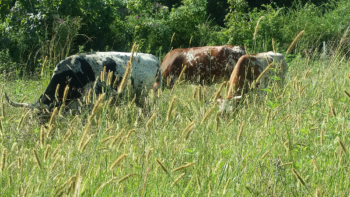
Grass height before grazing. Photo: Felicia Bell, NCAT
During this period without grazing, landowners can observe the effects of high-density grazing with an extended recovery time. In some cases, producers see dramatic vegetation changes, improved land function, and more water being captured and stored in the soil. In all cases, producers get evidence they can trust about how their land responds to high-density grazing. They see it with their own eyes and on their own land, understanding more deeply how their land responds to high-density grazing. If a producer can regenerate small areas of land and move animals at a high stock density, it’s possible to achieve good animal performance while regenerating the land.
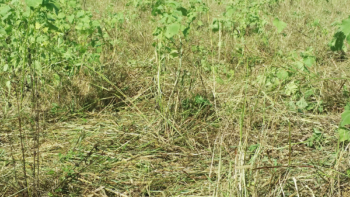
Grass height after grazing. Photo: Felicia Bell, NCAT
Ms. Brooks’ trial was accomplished with what she had available on the farm… and, in her case, that was pallets. For the trial, Ms. Brooks and I constructed a small paddock using the wall of the barn on one side and pallets to enclose the other sides. Following Hand’s advice, we made the paddock small enough to truly test stock density while having minimal impact on the farm’s total forage.
The stock density was about one square yard per goat. This level of stock density has shown success in generating perennial plant germination—instead of annuals—during recovery, which helps the land regenerate more quickly through a rapid plant succession. We also wanted animal density to be high enough to achieve uniform paddock utilization, instead of the mosaic pattern typical of partial-rest grazing. Light stocking encourages animals to graze some spots to the ground, while leaving other spots totally ungrazed. This is a common grazing problem seen throughout the Southeast.

Setting up a small paddock for the Safe to Fail Grazing Trial on Ms. Brooks’ farm. Photo from video: Felicia Bell, NCAT
The goats stayed in the enclosure for at least three hours, resulting in the area being eaten, trampled, and having manure spread over it by the animals. Ms. Brooks will now allow the land to recover for a full year while comparing this paddock to adjacent areas with normal grazing pressure. The recovery period is an opportunity to observe the growth response of plant species, looking for indicators of soil health improvement and shifts within the soil microbe community. We hope that Ms. Brooks will learn a great deal from this experiment and will encourage other farmers in the area to run similar trials.
We made sure that our Mississippi working group included several generations. Some of the younger generations are savvy and can navigate assistance programs more easily than those in their 60s and 70s, who really don’t know what to do when they go to USDA for assistance. When Ms. Brooks received pushback in her application process for NRCS assistance, she didn’t just stop. She joined a farmer cooperative and was successful in receiving NRCS assistance after she learned from people who look like her what questions to ask. Other members of her cooperative held her hand and walked with her through the process.
Ms. Brooks not only overcame her own difficulty accessing USDA programs, but she also discovered that it’s much easier to visit the USDA Service Center with other farmers, as a group. Like other farmers in the South, she has found that it’s very helpful to go in with someone who has been through the process and can help with the application. It’s also important to ask for a statement of service: a receipt ensuring that the application is processed in a timely fashion.
In our project, we saw over and over again that the effects of discrimination against Black farmers in Mississippi are real and powerful. And there’s no doubt that discrimination is still happening. On the other hand, Ms. Brooks provided an inspiring example of how these barriers can be overcome. There is a huge lack of education for Black farmers in Mississippi. Participating in a group or having a supportive mentor can sometimes make all the difference in the world, enabling people to overcome their intimidation and fear of the USDA Service Center to access programs and technical assistance to which they are legally entitled.
Conclusion: We are all in this together
The experiences of the farmers profiled in this publication all reinforce the importance of collective efforts to explain conservation programs in Mississippi as a means of breaking barriers to participation. This includes explaining how the application process works and how and when participants are selected. It seems very basic, but simply explaining the criteria and procedures for obtaining a successful contract, and walking a new farmer through the process, may be one of the most powerful things that could be done to improve the accessibility and participation in conservation programs by small and limited-resource farms in Mississippi. Just as important is an appreciation for the environmental and human community impacts of small farms and how conservation programs align with the principles of sustainable agriculture.
Researchers have documented a huge disparity between Black and white farmers in receiving financial assistance (Russell et al., 2021) for programs that would support their profitability and ability to implement regenerative practices. In comparison to some other states, we saw very clearly that Mississippi lacks a solid support system for Black farmers beyond Alcorn State University, the state’s 1890 Land Grant Institution. Stronger partnerships between Alcorn State, Mississippi State, and state and regional nonprofits could potentially benefit Black farmers by integrating them into the broader sustainable agriculture movement. As an example from another state in our project, Virginia State University and the Virginia Association for Biological Farming have begun to hold their annual conferences jointly, adding to the richness and diversity of the local foods, food security, sustainable agriculture, and community development movements within Virginia.

Covington County Self Help Association in Mississippi, 2021. Photo: Felicia Bell, NCAT
In addition to parity in conservation program contracts, we noticed that participants in our project could benefit greatly from business training to help them learn the proper procedures and requirements to run a farm business. Also helpful would be grant-writing assistance, to get the basic knowledge to write a grant or work with a grant writer. A cooperative association of farmers, Extension, and nonprofits may be able to develop a better culture of inclusion and resilience in Mississippi, as has happened in other states.
Individualism is a strong theme in the United States. We are encouraged to go it alone, take responsibility, and benefit from the fruits of our labor. It’s a solid idea, but the narrative of individualism is far from accurate when describing the actual situation in American agriculture. In commodity farming, groups of farmers come together to shape policy, enact legislation, and share resources. Farmers who lack this kind of support are left out, not only in the planning process, but in receiving technical and financial assistance (SAGE, 2021).
The farmers’ stories told in this article are all about barriers to participating in conservation programs. But they’re also stories about reversing our collective exploitation of the land, when you consider the facts of small farm productivity, local knowledge, and resiliency. Something as simple as Ms. Randle’s Safe to Fail Trial could have a great impact on encouraging farmers across the South to regenerate their land. Better grazing practices have impacts beyond the farm. From water infiltration into the soil comes stream and river regeneration. When better grazing is augmented with practices such as buffer strips, native plantings, and cover crops, the impacts multiply and accelerate. Without full participation in conservation programs–regardless of race, gender, farm size, or enterprise–we are unlikely to achieve the goal of equity in food production, much less the regeneration of crucial food-production landscapes.
Lessons Learned from the Mississippi Working Group
- Farmers who joined a community group, grazing group, or cooperative learned and shared new information and got feedback and encouragement. The chances of small-farm success were greatly enhanced when the farmer was a part of a group or had a mentor.
- On-farm research increased the scope of enterprises and helped farmers learn from experience. Safe to Fail Trials proved an excellent way to do this, and we think this technique has great potential to be promoted more widely in Mississippi. The Safe to Fail approach is ideally suited to the needs of small, limited-resource producers.
- Successful adopters of regenerative practices in our project all had an ethic of listening to the land. They have learned how to observe what the land is telling them and adapt to what the land can support. Choosing the right enterprise for the land is fundamental to sustainable, regenerative farming.
- We also saw successful farmers seeking out opportunities to learn and applying the holistic principles of whole-farm planning. Determining values and goals, setting them realistically, and checking them through farm-management-planning tools and financial documents are all crucial for farm viability.
- Successful adoption of regenerative practices requires planning and preparation. Farmers told their stories of how they read, attended workshops and field days, and learned the basics of regenerative farming before investing in infrastructure. They started small and used on-farm materials as much as possible. Tools and infrastructure are necessary but are merely added expenses unless the farmer has the knowledge of how to use them.
References
Russell, K.J., L. Hossfeld, and G. Rico Mendez. 2021. Not a new pattern: Black farmers’ perspectives on barriers to participating in federal farm programs. Journal of Agriculture, Food Systems, and Community Development. Vol. 10, No. 4. p. 195–209.
SAGE. 2021. Land Access and Farm Business Viability for Limited Resource Farmers. California FarmLink and Sustainable Agriculture Education (SAGE).
Resources
Soil for Water
NCAT’s Soil for Water project website celebrates the amazing water-holding ability of healthy soil and encourages on-farm research and discovery. It includes a story collection, peer-to-peer learning opportunities, and resources for farms and ranches interested in catching and holding more water in their soils.
Managing Soils for Water: How Five Principles of Soil Health Support Water Infiltration and Storage
Too often, the approach to dealing with water deficits has focused exclusively on better technology: deeper wells, better drip emitters, more efficient micro-sprinklers, and variable-speed drives on pumps. While all of these are important, this ATTRA publication discusses a different approach that focuses on maintaining healthy soils by following five basic principles.
Grazing Networks for Livestock Producers
Grazing networks promote a mutual self-help approach to learning that is based on shared local experience and provides several benefits to participants. This ATTRA publication offers suggestions for finding or starting a grazing network and provides examples of the kinds of activities grazing networks might conduct. It also contains recommendations for sustaining a grazing network over time.
UnderstandingAg, LLC
UnderstandingAg provides on-farm consulting in soil health practices to help farmers achieve their goals. Their website offers information on the principles and practices of regenerative farming through an extensive resource and video library.
Acknowledgment
This publication is based upon work that is supported by the National Institute of Food and Agriculture, U.S. Department of Agriculture, under award number 2020-38640-31521 through the Southern Sustainable Agriculture Research and Education program under subaward number LS21-345. USDA is an equal opportunity employer and service provider. Any opinions, findings, conclusions, or recommendations expressed in this publication are those of the author(s) and do not necessarily reflect the view of the U.S. Department of Agriculture.
![]()

